|
|
氧化磷酸化是細胞中重要的生化過程,是細胞呼吸的最終代謝途徑,位於糖酵解和三羧酸循環之後,是産生“能量通貨”atp的主要步驟。這一過程可看作電子傳遞過程中偶聯adp磷酸化,生成atp。
氧化磷酸化發生在原核生物的細胞膜,或者真核生物的綫粒體內膜上。過程由兩部分組成:電子傳遞鏈和atp合酶。前者氧化由糖酵解和三羧酸循環産生的nadh和fadh2,同時將質子泵出細胞膜或綫粒體內膜,産生質子梯度;後者,也稱為復合體v,利用質子梯度導致的質子內流將adp和磷酸合成為atp,從而將氫載體氧化産生的能量以atp的形式保存。
産生atp的計算
到目前為止,電子傳遞鏈中一分子nadh或fadh2被氧化所泵出的質子數,以及atp合成酶合成一個atp所需的質子數仍然都是未知,而半個氧分子被還原(等同於一個nadh或fadh2被氧化)時所産生的atp稱作p/o值。對此,已有很多實驗試圖計算這兩個值,但仍未取得一致意見。對於電子傳遞鏈,目前最公認的結論是一個nadh被氧化泵出10個質子,一個fadh2被氧化泵出6個。而合成一分子atp大約需要4個質子內流。則對於nadh,p/o值約為2.5,而fadh2的p/o值約為1.5。然而也有的教科書認為p/o值分別為3和2。 |
|
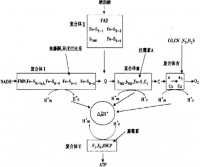 氧化磷酸化 氧化磷酸化 氧化磷酸化 氧化磷酸化 |
氧化磷酸化的概念和偶聯部位 Concept and oxidative phosphorylation coupling portions |
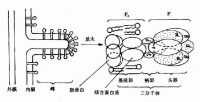 氧化磷酸化的概念和偶联部位 氧化磷酸化的概念和偶联部位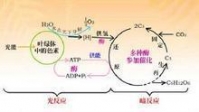 氧化磷酸化的概念和偶联部位 氧化磷酸化的概念和偶联部位 氧化磷酸化的概念和偶联部位 氧化磷酸化的概念和偶联部位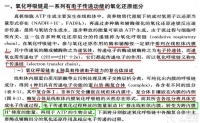 氧化磷酸化的概念和偶联部位 氧化磷酸化的概念和偶联部位 氧化磷酸化的概念和偶联部位 氧化磷酸化的概念和偶联部位
2.偶聯部位:根據實驗測定氧的消耗量與ATP的生成數之間的關係以及計算氧化還原反應中ΔGO'和電極電位差ΔE的關係可以證明。
P/O比值是指代謝物氧化時每消耗1摩爾氧原子所消耗的無機磷原子的摩爾數,即合成ATP的摩爾數。實驗表明, NADH在呼吸鏈被氧化為水時的P/O值約等於3,即生成3分子ATP;FADH2氧化的P/O值約等於2,即生成2分子ATP。
氧-還電勢沿呼吸鏈的變化是每一步自由能變化的量度。根據ΔGO'= - nFΔE O'(n是電子傳遞數,F是法拉第常數),從NADH到Q段電位差約0.36V,從Q到Cytc為0.21V,從aa3到分子氧為0.53V,計算出相應的ΔGO'分別為69.5、40.5、102.3kJ/mol。於是普遍認為下述3個部位就是電子傳遞鏈中産生ATP的部位。
NADH→NADH脫氫酶→‖Q → 細胞色素bc1復合體→‖Cytc →aa3→‖O2 |
胞液中NADH的氧化 Oxidation of cytosolic NADH |
 氧化磷酸化 胞液中NADH的氧化 氧化磷酸化 胞液中NADH的氧化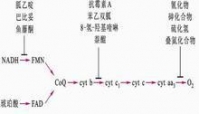 氧化磷酸化 胞液中NADH的氧化 氧化磷酸化 胞液中NADH的氧化 氧化磷酸化 胞液中NADH的氧化 氧化磷酸化 胞液中NADH的氧化 氧化磷酸化 胞液中NADH的氧化 氧化磷酸化 胞液中NADH的氧化
(一)α-磷酸甘油穿梭作用
這種作用主要存在於腦、骨骼肌中,載體是α-磷酸甘油。
胞液中的NADH在α-磷酸甘油脫氫酶的催化下,使磷酸二羥丙酮還原為α-磷酸甘油,後者通過綫粒體內膜,並被內膜上的α-磷酸甘油脫氫酶(以FAD為輔基)催化重新生成磷酸二羥丙酮和FADH2,後者進入琥珀酸氧化呼吸鏈。葡萄糖在這些組織中徹底氧化生成的ATP比其他組織要少,1摩爾G→36摩爾ATP。
(二)蘋果酸-天鼕氨酸穿梭作用
主要存在肝和心肌中。1摩爾G→38摩爾ATP
胞液中的NADH在蘋果酸脫氫酶催化下,使草酰乙酸還原成蘋果酸,後者藉助內膜上的α-酮戊二酸載體進入綫粒體,又在綫粒體內蘋果酸脫氫酶的催化下重新生成草酰乙酸和NADH。NADH進入NADH氧化呼吸鏈,生成3分子ATP。草酰乙酸經𠔌草轉氨酶催化生成天鼕氨酸,後者再經酸性氨基酸載體轉運出綫粒體轉變成草酰乙酸。 |
氧化磷酸化偶聯機製 Oxidative phosphorylation coupling mechanism |
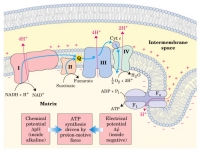 氧化磷酸化偶联机制 氧化磷酸化偶联机制 氧化磷酸化偶联机制 氧化磷酸化偶联机制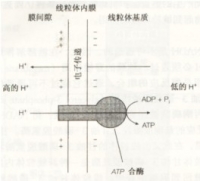 氧化磷酸化偶联机制 氧化磷酸化偶联机制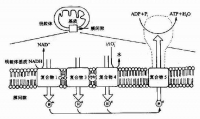 氧化磷酸化偶联机制 氧化磷酸化偶联机制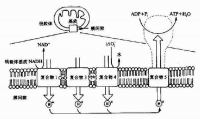 氧化磷酸化偶联机制 氧化磷酸化偶联机制
1961年,英國學者Peter Mitchell提出化學滲透假說(1978年獲諾貝爾化學奬),說明了電子傳遞釋出的能量用於形成一種跨綫粒體內膜的質子梯度(H+梯度),這種梯度驅動ATP的合成。這一過程概括如下:
1.NADH的氧化,其電子沿呼吸鏈的傳遞,造成H+ 被3個H+ 泵,即NADH脫氫酶、細胞色素bc1復合體和細胞色素氧化酶從綫粒體基質跨過內膜泵入膜間隙。
2.H+ 泵出,在膜間隙産生一高的H+ 濃度,這不僅使膜外側的pH較內側低(形成pH梯度),而且使原有的外正內負的跨膜電位增高,由此形成的電化學質子梯度成為質子動力,是H+ 的化學梯度和膜電勢的總和。
3.H+ 通過ATP合酶流回到綫粒體基質,質子動力驅動ATP合酶合成ATP。
(二)ATP合酶
ATP合酶由兩部分組成(Fo-F1),球狀的頭部F1突嚮基質液,水溶性。亞單位Fo埋在內膜的底部,是疏水性蛋白,構成H+ 通道。在生理條件下,H+ 衹能從膜外側流嚮基質,通道的開關受柄部某種蛋白質的調節。 |
|
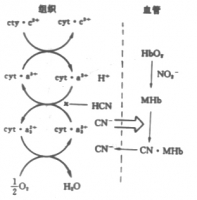 影响氧化磷酸化的因素 影响氧化磷酸化的因素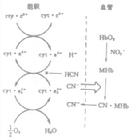 影响氧化磷酸化的因素 影响氧化磷酸化的因素
能阻斷呼吸鏈某一部位電子傳遞的物質稱為呼吸鏈抑製劑。
魚藤酮、安密妥在NADH脫氫酶處抑製電子傳遞,阻斷NADH的氧化,但FADH2的氧化仍然能進行。
抗黴素A抑製電子在細胞色素bc1復合體處的傳遞。
氰化物、CO、疊氮化物(N3-)抑製細胞色素氧化酶。
對電子傳遞及ADP磷酸化均有抑製作用的物質稱氧化磷酸化抑製劑,如寡黴素。
(二)解偶聯劑
2,4-二硝基苯酚(DNP)和頡氨黴素可解除氧化和磷酸化的偶聯過程,使電子傳遞照常進行而不生成ATP。DNP的作用機製是作為H+的載體將其運回綫粒體內部,破壞質子梯度的形成。由電子傳遞産生的能量以熱被釋出。
(三)ADP的調節作用
正常機體氧化磷酸化的速率主要受ADP水平的調節,衹有ADP被磷酸化形成ATP,電子纔通過呼吸鏈流嚮氧。如果提供ADP,隨着ADP的濃度下降,電子傳遞進行,ATP在合成,但電子傳遞隨ADP濃度的下降而減緩。此過程稱為呼吸控製,這保證電子流衹在需要ATP合成時發生。 |
百科大全 Wikipedia Encyclopedia |
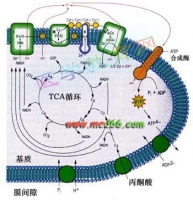 氧化磷酸化 百科大全 氧化磷酸化 百科大全
物質氧化與ADP磷酸化偶聯的過程。綫粒體中生物氧化時,作用物在脫氫酶的作用下脫下的氫通過呼吸遞氫體係逐步地傳遞給氧生成水的過程中,消耗氧,消耗無機磷酸,生成高能磷酸鍵使ADP磷酸化成ATP。 |
|
- : oxidative phosphorylation
|
|
|